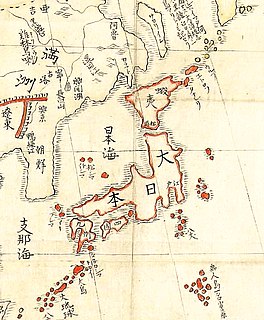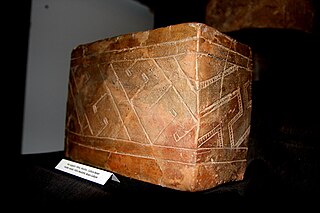
A megalith is a large pre-historic stone that has been used to construct a structure or monument, either alone or together with other stones. There are over 35,000 in Europe alone, located widely from Sweden to the Mediterranean sea.

A paddy field is a flooded field of arable land used for growing semiaquatic crops, most notably rice and taro. It originates from the Neolithic rice-farming cultures of the Yangtze River basin in southern China, associated with pre-Austronesian and Hmong-Mien cultures. It was spread in prehistoric times by the Austronesian expansion to Island Southeast Asia, Southeast Asia including Northeastern India, Madagascar, Melanesia, Micronesia, and Polynesia. The technology was also acquired by other cultures in mainland Asia for rice farming, spreading to East Asia, Mainland Southeast Asia, and South Asia.

Sacheon is a city in South Gyeongsang Province, South Korea. Sacheon's chief fame comes from its being the site of two naval battles in the Seven Year War.
The year 1975 in archaeology involved some significant events.

The Mumun pottery period is an archaeological era in Korean prehistory that dates to approximately 1500-300 BC This period is named after the Korean name for undecorated or plain cooking and storage vessels that form a large part of the pottery assemblage over the entire length of the period, but especially 850-550 BC.

Igeum-dong is a complex archaeological site located in Igeum-dong, Samcheonpo in Sacheon-si, South Gyeongsang Province, South Korea. This prehistoric archaeological site is important in Korean prehistory because it represents solid evidence that simple chiefdoms formed in as early as the Middle Mumun, some 950 years before the first state-level societies formed in Korea. The settlement is dated by pottery, pit-house types, and an AMS radiocarbon date to the Late Middle Mumun Pottery Period. Test excavations were conducted in 1997, and wide-scope horizontal excavations took place in 1998 and 1999.

Yoshinogari is the name of a large and complex Yayoi archaeological site in Yoshinogari and Kanzaki in Saga Prefecture, Kyūshū, Japan. According to the Yayoi chronology established by pottery seriations in the 20th century, Yoshinogari dates to between the 3rd century BC and the 3rd century AD. However, recent attempts to use absolute dating methods such as AMS radiocarbon dating have shown that the earliest Yayoi component of Yoshinogari dates to before 400 BC.

Songguk-ri is a Middle and Late Mumun-period archaeological site in Buyeo-gun, Chungcheongnam-do, South Korea. Songguk-ri is a settlement and burial site that is important in the study of Korean prehistory. It is registered as Historical Site No. 249. Songguk-ri is a main point of reference in Korean prehistory—Korean archaeologists have represented the prehistoric village and the material culture excavated from there as the type-site for Middle Mumun Culture in southern Korea.

Prehistoric Korea is the era of human existence in the Korean Peninsula for which written records do not exist. It nonetheless constitutes the greatest segment of the Korean past and is the major object of study in the disciplines of archaeology, geology, and palaeontology.

Shell Mound in Dongsam-dong, Busan is located on the west coast of Yeong-do Island in Dongsam-dong, Yeongdo District, Busan, South Korea.

The Boian culture, also known as the Giuleşti–Mariţa culture or Mariţa culture, is a Neolithic archaeological culture of Southeast Europe. It is primarily found along the lower course of the Danube in what is now Romania and Bulgaria, and thus may be considered a Danubian culture.

The Plum Island Eagle Sanctuary is a 52-acre island in the Illinois River owned by the Illinois Audubon Society. It was purchased March 24, 2004 to act as a wildlife sanctuary, to protect foraging habitat for wintering bald eagles. It is close to Matthiessen State Park and adjacent to Starved Rock State Park.
Rucker's Bottom Site (9EB91) is an archaeological site in located on the Upper Savannah River in Elbert County, Georgia.

The Jeulmun pottery period is an archaeological era in Korean prehistory broadly spanning the period of 8000–1500 BC. This period subsumes the Mesolithic and Neolithic cultural stages in Korea, lasting ca. 8000–3500 BC and 3500–1500 BC, respectively. Because of the early presence of pottery, the entire period has also been subsumed under a broad label of "Korean Neolithic".

The Moccasin Bluff Site is an archaeological site located along the Red Bud Trail and the St. Joseph River north of Buchanan, Michigan. It was listed on the National Register of Historic Places in 1977, and has been classified as a multi-component Prehistoric site with the major component dating to the Late Woodland/Upper Mississippian period.
Whittlesey culture is an archaeological designation for native people who lived in northeastern Ohio during the Late prehistoric and Early Contact period between A.D. 1000 to 1640. They flourished as an agrarian society by 1500—growing maize, beans, and squash—when their populated began to decrease due to disease, malnutrition, and warfare. There was a period of long, cold winters that would have impacted their success cultivating food from about 1500. The Whittlesey culture people created a distinctive style of pottery and built villages that were designed to be defensive, set high on promontories with steep cliffs and then surrounded by ditches or stockades. The villages were established on the Lake Erie plain or overlooking river and streams. About 1640, Whittlesey villages were abandoned and due to the displacement of native groups during the early contact period with Europeans, it is not known where or how they relocated.

The Griesmer site (La-3) is located on the Kankakee River in Lake County, Indiana, about a mile southeast of Schneider, in Northwestern Indiana. It is classified as a Prehistoric, multi-component site with Middle Woodland, Late Woodland and Upper Mississippian occupations. The deposits were not stratified, but observation of the types of artifacts present, together with radiocarbon dates, helped to define the sequence of occupations at the site.

The Hoxie Farm Site (11Ck-4) is located on Thorn Creek in Thornton, Illinois Cook County Forest Preserve in Cook County, Illinois, near the city of Chicago. It is classified as a late Prehistoric to Protohistoric/Early Historic site with Upper Mississippian Huber affiliation.

The Oak Forest Site (11Ck-53) is located in Oak Forest, Cook County, Illinois, near the city of Chicago. It is classified as a late Prehistoric to Protohistoric/Early Historic site with Upper Mississippian Huber affiliation.

The Anker Site (11Ck-21) is located on the Little Calumet River near Chicago, Illinois. It is classified as a late Prehistoric site with Upper Mississippian Huber affiliation.












